Text

Teaching Generative Music With Modular Synths – Part 19
Chapter 5.2:
Sonic Kinfolk
(Excerpt from my e-book about making generative music – volume 1)
But it is not always about a kind of “chief” or “master” modulator (which, by the way, itself can be a complex network). Similar but different questions concerning polyphonic patches read: Which voices shall have which sources (triggers, gates, LFOs, other modulators etc.) in common? Which of of them shall be common sources all the time, and which shall be switched to only sometimes?
And even in monophonic patches do these questions exist and have to be answered BEFORE taking to the cables. Here in monophonic patches they read: Which modulating or triggering CV from anywhere (where?) in the patch shall do their modulating or triggering work in which other parts of the patch? And again: Always? Or only switched on from time to time?
A composer will ask and find the answers (a long time) before he or she patches the first cable. Of course it is about structure again, but not about the “big throw”, the overall kind of structure of the example from the beginning of this chapter. No, here I am talking about how and how much the individual parts of the piece are interwoven, what sonic, what musical relationships I want to set up.
Time for examples, I think.
In the first example there are 2 voices of quite different sonic character: a sine wave that is sent through a wave folder, and a smooth voice from BASAL. The pitch development of both voices is random (NOISE+S&H). The sound of the folded sine wave is always dominant in this mix of two sounds. But I want the acoustical dominance to rotate between the two voices. But I don´t want to change or modulate the volume of any of the voices. My (musical) goal is: the higher the pitch of the smooth BASAL voice is, the less is the wave of voice 1 (INSTRUO) folded, and vice versa. This means with deeper and less “penetrative” timbres of the BASAL voice the INSTRUO voice becomes more folded and prominent - and vice versa. As a result I get the change in leadership between the voices that I want. Technically I take the output of the S&H module of voice 2 (BASAL), send it through an inverter and from there I modulate the MIX function of the wave folder. The higher the level of the CV output of the S&H module, the less folded the sine wave reaches the audio mixer.
The preset “chapter_5_preset_5” and the following video show this example (video and preset only in my book. Get it here: https://www.dev.rofilm-media.net/node/467)
Now I take this patch and develop it further. This time I want to set up an interrelation not between the two voices, but between two parts (parameters) of one and the same voice (voice 2, BASAL). I want higher pitches to develop faster, and lower pitches to hold the notes for a longer time. To achieve that I patch the output of the S&H module of voice 2 to the FM input of the LFO that triggers this S&H module. Additionally I don´t send the S&H module´s output directly to the quantizer, but use the upper part of the double attenuverter module to add an offset to the pitch CV from the S&H module, because I don´t want the newly created quite long low pitches to be too low. At the same time I limit the pitch range using the attenuator knob of the upper part of the double attenuverter module.
The preset “chapter_5_preset_6” and the following video (videos only in the e-book)show this extended patch (video and preset only in my book. Get it here: https://www.dev.rofilm-media.net/node/467)
You surely have got what I have done by now (in this patch): I have set up a group of three parameters, have given them a common musical meaning, and let them – despite all randomness – commonly walk their musical route (pitch of voice 2, “speed” of voice 2 and amount of wave folding in voice 1).
… to be continued
Stay creative and enjoy your day!
Rolf
or what about visiting our Facebook group: https://www.facebook.com/groups/rofilmmedia
#generative#generativemusic#modularsynths#musicproduction#sounddesign#sequencer#sequencers#makinggenerativemusic#modulargenerative#generativemodular#learninggenerative#learningmodular
0 notes
Text

All e-books contain hundreds of example videos. This offer ends 15 January 2023 and won´t be prolonged. Read all the details here: https://dev.rofilm-media.net
Enjoy your day!
Rolf
#generative#generativemusic#modularsynths#musicproduction#sounddesign#sequencer#sequencers#makinggenerativemusic#modulargenerative#generativemodular#learninggenerative#learningmodular#grains#granular#granularsynthesis#granularsoundprocessing#sonicgrains#noise#experimental#electronicmusic#experimentalmusic
0 notes
Text
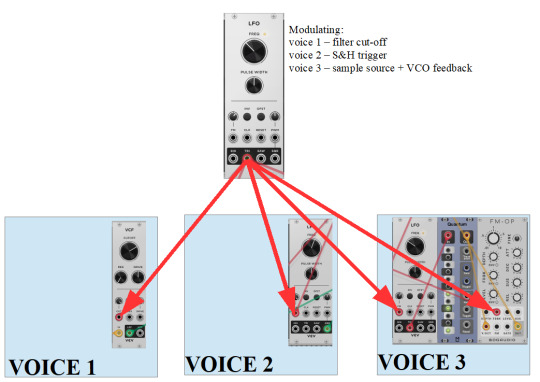
Teaching Generative Music With Modular Synths – Part 18
There three voices in the patch: the left one with the VCV Rack VCO as the sound engine, the middle voice with BASAL as the sound source, and the right voice with the FM-OP as sound source. The VCO and BASAL are pitch modulated by S&H modules, whose CV is quantised to a C-minor chord. The FM-OP is pitch modulated by an LFO (and again the CV is quantised to a C-minor chord).
The “master” LFO on top modulates (at the same time): the cut-off frequency of the filter in voice 1 (the left one), and rate of the trigger LFO in the middle voice, and the rate of the LFO as well as the amount of feedback in the right voice. These 4 parameters build one “compositional” group, don´t change independently but parallel.
Perhaps you have already got it: grouping parameters and subordinate them under one and the same modulator means imposing musical structure to the piece. This becomes even more obvious when we use a couple of sequencers as modulators, sequencers who are clocked by a master clock, as in the preset “chapter_5_preset_3” and the following video clip: https://youtu.be/TsS9vS3mJWk
By inserting inverter modules (attenuverters) between these “chief modulators” (which don´t have to be always LFOs of course) and certain parameters of a group we can make some parameters run “anti-parallel” and nevertheless still be in this same group. The preset “cuapter_5_preset_4” and the following video show an example: https://youtu.be/hpBXWBZEzjU
The decision which parameters from where all over the patch belong to the same group and shall be modulated parallel (or anti-parallel) is solely to the composer to make. There will be combinations that don´t make a lot of sense – I mean musically, and there will be combinations that make a lot of sense (but don´t overdo things). But it´s on you to decide. Decide according to your taste, your understanding of the piece, your will and your skills as the composer.
… to be continued
Stay creative and enjoy your day!
Rolf
or what about visiting our Facebook group: https://www.facebook.com/groups/rofilmmedia
#generative#generativemusic#modularsynths#musicproduction#sounddesign#sequencer#sequencers#makinggenerativemusic#modulargenerative#generativemodular#learninggenerative#learningmodular
0 notes
Text
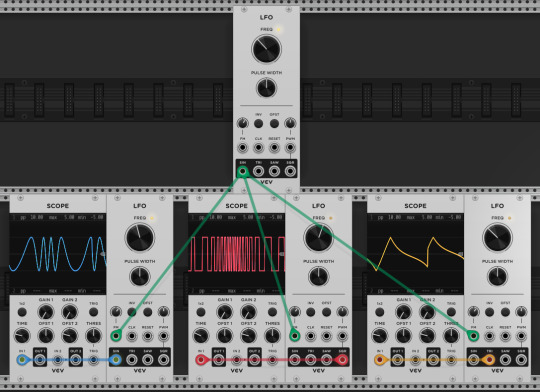
Teaching Generative Music With Modular Synths – Part 17
But even with chains of modulators of the same kind it is possible to think of hierarchically different levels: when one of the modulators (let´s take LFOs again) modulates a couple of other modulators of the same kind PARALLEL. Then, this one can be understood as sitting at a higher hierarchical level (it influences more than one outcome, whereas each of the others influences only its one individual modulation target.
Determining such groups of parameters by getting them modulated by one and the same modulation source (which may be a complex modulation network or only a single modulator module) is a compositional act representing my will as the composer of the piece. I´d like to call this “compositional strategy 1”.
The preset “chapter_5_preset_2” and the video clip the following link leads you to show an example:
youtube
… to be continued
Stay creative and enjoy your day!
Rolf
or what about visiting our Facebook group: https://www.facebook.com/groups/rofilmmedia
#generative#generativemusic#modularsynths#musicproduction#sounddesign#sequencer#sequencers#makinggenerativemusic#modulargenerative#generativemodular#learninggenerative#learningmodular#Youtube
0 notes
Text

What do Tolkien´s evil wizard Saruman and old yoghurt have in common? Well, part 1 of my new series “Fun with Field Recording and Sound Design” shows it:
youtube
Timeline / Content
00:00 Introduction
00:36 The Task
00:56 Explaining the set-up
02:20 Generating and Recording the Sounds
07:16 The Volcano
07:49 First Audition of the Recordings
10:40 The (temporary) End
Link to my website: https://dev.rofilm-media.net
Enjoy your day!
Rolf
#sounddesign#fieldrecording#blubs#saruman#yoghurt#tolkien#funwithsounddesign#funwithfieldrecording#gear#soundrecordinggear#fieldrecordinggear#sounddesigninggear#piezo#piezomicrophones#contactmicrophones#samplepack#zoomH5#zoom#H5#sound#Youtube
0 notes
Text
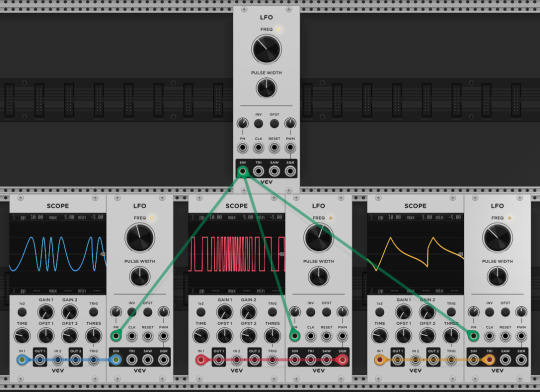
Teaching Generative Music With Modular Synths – Part 17
But even with chains of modulators of the same kind it is possible to think of hierarchically different levels: when one of the modulators (let´s take LFOs again) modulates a couple of other modulators of the same kind PARALLEL. Then, this one can be understood as sitting at a higher hierarchical level (it influences more than one outcome, whereas each of the others influences only its one individual modulation target.
Determining such groups of parameters by getting them modulated by one and the same modulation source (which may be a complex modulation network or only a single modulator module) is a compositional act representing my will as the composer of the piece. I´d like to call this “compositional strategy 1”.
The preset “chapter_5_preset_2” and the video clip the following link leads you to show an example:
youtube
… to be continued
Stay creative and enjoy your day!
Rolf
or what about visiting our Facebook group: https://www.facebook.com/groups/rofilmmedia
#generative#generativemusic#modularsynths#musicproduction#sounddesign#sequencer#sequencers#makinggenerativemusic#modulargenerative#generativemodular#learninggenerative#learningmodular#Youtube
0 notes
Text

The Cradles of Electronic Music – Part 4
“The frequency of silence is 16 Hz” or “How a mayfly taught me the sound of life”
Let´s do a thought experiment to tune ourselves in and experience a bit of the spirit of these early days of electronic music.
If a mayfly had something like a consciousness – I don´t know whether or not there is consciousness in the brains of these animals – one single second would seem a remarkably long time to it, because one second represents about 0.0012 percent of its whole life span, which equals about 8 hours in human life – a whole working day.
These thoughts were spooking in my brain while I was watching a mayfly crawling about on the window pane. But what is a second? How long is a second? How long is any time span? What is the meaning of a certain time span? And suddenly: Is there an equivalent of time in sound, in timbre? How does time sound? One second after the other, legions of seconds are ticking by. And then: WOW! It´s a repetition, time goes in cycles, in cycles of time. The length of time is time itself, one second lasts exactly one second, the length of the cycles of a second is a second, THE FREQUENCY OF TIME IS 1 Hertz! The pitch of time is 1 Hz.
I can not hear a pitch of 1 Hertz. It´s far too low. The lowest note in the western equal-tempered scale with A4 at 440 Hz is C0 at 16.35 Hz. therefore 1 Hz is 4 octaves below at a note which we would have to call “C-4” if it existed. Hm?! But not really. This ominous C-4 would have a frequency of 1.021875 Hz (16.35 divided by 2 divided by 2 divided by 2 divided by 2). Of course! Something THAT fundamental like time would hardly depend on such a thing like our equal-tempered scale. So let´s walk the other direction: from 1 Hz 4 octaves up into the regioon of audibility to exactly 16 Hz (some cents below C0). The sonic representation of time is 16 Hz.
But what is time if nothing is going on? What is the musical equivalent to “nothing is going on”? Well, it´s silence. WOW! Silence has a frequency, a pitch: 16 Hz!
But a perception of “nothing is going on” is wrong. There is at least one thing, one event going on – always going on: the elapsing of time. Or in my musical equation: there is no silence, there is always at least this note, this tone, this pitch of 16 Hz.
The mayfly on the window pane took a rest here – just as if it had sensed that I had come to a first conclusion. I turned to my coffee and took a sip before my attention returned to the insect again. The mayfly spread its wings for a moment and then it began to crawl again.
There are time spans which are more than just larger chunks of time. Time spans that we sense as more meaningful than just a larger amount of seconds. The smallest of those remarkable time spans is a day. We see daytime and nighttime, we get tired, we sleep, we wake up, we go to work, there are a lot of regular activities depending on the time span of a day. One day lasts 86,400 seconds, the frequency of a day is 0.0000115 Hz. Transposing this frequency up into an audible rate we get 24.12 Hz (F0 is at 21.83 Hz – just by the way).
But perhaps I should take another value as a reference, another than this 1 Hz. Perhaps I should try to find a reference which influences our lives more directly. What about taking the time the earth needs to complete a full rotation as reference: 23 hours, 56 minutes and 4 seconds, which ads to 86,164 seconds, which brings us to 24.33 Hz in audible rate (even nearer to F0 – just by the way).
Let me use this system to calculate the audible pitches of a week, a month and a year. A week first: 24.33/7 (the cycle length is seven times longer than that of a day) = 3.48 Hz. 3.48 times 2 times 2 times 2 equals 27.84 Hz (nearly A0, which has 27.50 Hz).
For a month we come to 20.13 Hz (near by E0), when we take the sidereal month of the phases of the moon, and a year gets us to 17.01 Hz (sidereal year).
16 Hz, 17.01 Hz, 20.13 Hz, 24.33 Hz, 27.84 Hz seem to be kind of basic values. But what about the mayfly? Is it taking a break again? No, the animal is still striving to get through the glass of my window. It seems that I have to think even deeper. Do these frequencies represent a melody somehow? No, that´s nonsense. A melody means one pitch followed by another one. Seconds, days, weeks, years they are all at the same time. There´s always a certain week, as well as a certain day and a certain year. These frequencies are more like the partials in the spectrum of a sound, of a timbre – the sound of life. So, is the pitch of silence, are these 16 Hz the fundamental of the spectrum then? No, something is missing ��. of course: the beating of my heart! That´s the fundamental of the sound of life! A look in one of my numerous books teaches me: my heart beats between 70 times and 100 times per minute, what brings me to a frequency range of 1.17 Hz up to 1.67 Hz, which leads me to 18.72 Hz to 26.72 Hz after transposing my heart´s beats into audible regions. And as the fundamental of a sound is the lowest frequency (most of the times) in the spectrum of partials I have to transpose the other frequencies by 1 more octave:
heartbeat 18.72 to 26.72 Hz
silence 32 Hz
year 34.02 Hz
month 40.26 Hz
day 48.66 Hz
week 55.68 Hz
To make the spectrum complete I simply have to repeat these frequencies (but for the fundamental) in each octave: 64 Hz, 68.04 Hz, 80.52 Hz, 97.32 Hz, 111.36 Hz etc.
The mayfly seems to look back at me. Have I made a mistake? Yes, of course! The pitch of silence, the pitch of time itself, these 16 Hz they don´t change. These 16 Hz mustn´t be transposed at all, it´s the underlying pitch of everything.
Therefore I come to a constant low volume low pitched tone of 16 Hz above which my heart plays notes of 18.72 to 26.72 Hz the timbre of which is built by 24.02 Hz – 40.26 Hz – 48.66 Hz – 55.68 Hz – 68.04 Hz – 80.52 Hz – 97.32 Hz – 111.36 Hz etc. based on a heartbeat fundamental of 18.72 Hz. At faster heartbeats (up to 26.72 Hz) these partials have to be transposed equivalently.
And the different amplitudes, the changing amplitudes of these partials? Well, the amplitudes and theirs changes would represent the intensity or meaning of a day, a week or a year in my life. Or do I have to include more goings on of my life into this system? Goings on of more or less dramatic impacts (= amplitudes)?
Well, I think I have enough material to experiment with now – thank you, dear mayfly! So let me go and make some sound using Berna 3.
The next part in this series – it´s already going to be part 5 – describes and shows how I went on from here (there will be a video about it as well).
A thought hits my mind like a short but bright flash: Isn´t a spectrum the same as (layered) chords, at lest when working only with sine waves? But this is going to be another topic a bit later ion this series.
(more about it on https://dev.rofilm-media.net)
... to be continued
Enjoy your day!
Rolf
#electronicmusic#earlyelectronicmusic#stockhausen#eimert#Berio#berna3#musicproduction#em#electronicmusicproduction#fundamental#fundamentalfrequency#partials#spectrum#timbre#sound#silence#1950s#electronicmusic1950s
1 note
·
View note
Text
Rolf´s Infotalk 13: Suzanne Ciani is online now:
youtube
About performing Buchla, planning patches, spatial aspects and a lot more.
Content/Timeline:
0:00:00 Intro
0:02:57 Buchla + Orchestra On Vinyl
0:06:07 Analog Modular Is a Living Organic Medium
0:09:29 About Controlled Unexpectedness
0:10:58 How to Plan a Patch
0:14:56 Preparing For a Performance
0:17:45 Planning Doesn´t Mean Limiting
0:22:34 About Pitch And Timbre And Movement
0:24:14 About Spatial Movements
0:29:27 About Pitch, Noise And Diverse Sources of Sound
0:34:12 About Getting Oneself New Gear
0:38:28 About Sonic Scenes
0:39:53 About Analog And Digital
0:41:14 About the Cooperation Of Musicians And Instrument Producers
0:44:29 About Overly Complex Modules And Performability
0:53:26 Performing vs. Studio Work vs. Designing Sound
0:57:01 About Sound Design And Consciousness
0:58:29 About Musical Time Frames
1:03:20 About the Last 24 Hours Before a Concert
#ciani#suzanneciani#Buchla#BuchlaandOrchestra#quadrophonic#spatialmovement#Vinyl#producingavinyl#analog#digital#analogmodular#analogversusdigital#analogvsdigital#modularisliving#composingmodular#luckyaccidents#planningpatches#controlledunexpectedness#randomness#randommodular#modularrandom#learningbuchla#buchlaperformance#performingmodular#preparingforperformance#buchlakeyboard#modularimprovisation#sequencingsequences#pitchvstimbre#spatialrhythm
0 notes
Text

Teaching Generative Music With Modular Synths – Part 16
Chapter 5.1: Hierarchies of Modulations
The term “hierarchy” lets us automatically think of a master-and-slave structure. But that´s not what this chapter is about. Here I´m writing about hierarchies in meaning, in importance, hierarchies of influence. An LFO that modulates another LFO may be seen as the master, but it´s meaning, its importance isn´t any larger than that of the modulated (slave) LFO. Both together build a team with one outcome.
But when, on the other hand, an LFO modulates a lot of different parameters all over a large patch, then this LFO will be more influential in this patch than another LFO, which modulates only a single parameter somewhere in the patch. The first one occupies a higher position in the hierarchy of modulations, a higher position from the composer´s point of view. And so will not only this LFO, this modulation, but also the group of thus commonly modulated parameters! The existence of this influential LFO allows us to view and to understand these modulated parameters that may be scattered throughout the patch as a GROUP.
But things get different when there are different kinds of modulators in a “modulator-modulates-modulator” chain. An LFO that modulates the duration of an envelope whose CV levels deliver the sample source for a Sample & Hold module that modulates the pitch of an oscillator is surely at a higher hierarchical level (from the composer´s point of view) than the S&H module, because it coins the character of the succession of pitches through imposing a rhythmical structure and because the composer can set its parameters (wave shape and rate) and determine the result of these settings, foresee them (the preset “chapter_5_preset_1” shows an example of this constellation).
… to be continued
Stay creative and enjoy your day!
Rolf
or what about visiting our Facebook group: https://www.facebook.com/groups/rofilmmedia
#generative#generativemusic#modularsynths#musicproduction#sounddesign#sequencer#sequencers#makinggenerativemusic#modulargenerative#generativemodular#learninggenerative#learningmodular
0 notes
Text

New Concepts for Music And Sound – Part 1
To make in clear right at the beginning: this series of articles is not about having fun with or through music – not at all!
And let me begin in a rather vicious – and deliberately unfair – manner.
Imagine no piece of music had a title nor did it mention the author, the composer or the producer. And in case of songs – the worst of all musical forms – the name of the singer (or the singers to make a worst thing worse) wasn´t mentioned either.
Now be honest: would you be able to tell, if you had already heard the piece, or not? If it was sung (to mention the worst case again) by a certain torturer or by another? If you had heard the sounds, the timbres more than a thousand times or less often? And what about the chord progressions (there are chord progressions in it, right? - well more chord than progression in most cases)? And the melodic phrases, aren´t they somewhat familiar to you – since the late 1990s at least?
“But wait a minute!” I can hear you shouting (well, at least thinking). “It´s not me, who you are writing about! I´m an underground consumer!” Instead of “underground” you may say “progressive ambient”. Or “experimental”. Or “serious electronic”. Or “noise”. Or “serious contemporary”. You name it.
Let me answer to your objection by asking back:
Haven´t we even had these things long enough? Setting pianos on fire, breaking glass panes on the stage, even don´t doing anything. Plings and plangs, and crash and boom, and radio noises of all kinds. Or switching on a wall of synthesizer modules and letting them do what they want for hours and hours. We even have had music made with a couple of tractors in the field. We have been listening to noise of all kinds. We have heard recordings of cows crying of fear in the slaughterhouse while a string quartet is playing lullabies life on stage. Shall I continue? Do I have to continue to make you understand what I mean?
Imagine you were listening to the radio (yes, the old fashioned one – no mobile phone, no internet radio, no listening to a piece again whenever you like). How many pieces of contemporary music are there, which you would listen to until their complete end, even for the price of missing the bus and having an ugly conversation with your boss therefore?
Are there any sonic events that are worth crawling out of bed in the morning?
Is there still anything out there in the world of music and sound that is capable of surprising you? I mean REALLY surprising, so that you are standing there, open mouthed, and thinking: “WHAT THE F**K IS THAT?”
And what about you, you virtuosos of so called classical serious music? You have toiled for endless years only to play in front of an audience, three quarters of which have only come because of the business meetings outside at the champagne bar in the break, and the majority of the remaining quarter is simply looking for a suitable spouse for their children (or offering to be one). And you yourself? Are you producing something surprising? Something else than the other 5 or 6 top instrumentalists in the world? Something really individual? Something with differences of real meaning?
Hereby I invite you. You all. You fine players of instruments, you composers and producers, you worshippers of noise or ambient, you consumers of endlessly blaring pseudo-music, of the same piece again and again, always with another title though, and another face opening and closing their mouth, you regular visitors of classical piano concerts, you aged punks, you nostalgic “our music was better back in the days” freaks.
Be invited to an ugly expedition to new sonic worlds, to new – really new – ways of thinking about sonic goings on, new ways of consuming sonic events, new ways of generating sonic goings on – to new concepts of music and sound.
… to be continued
0 notes
Text



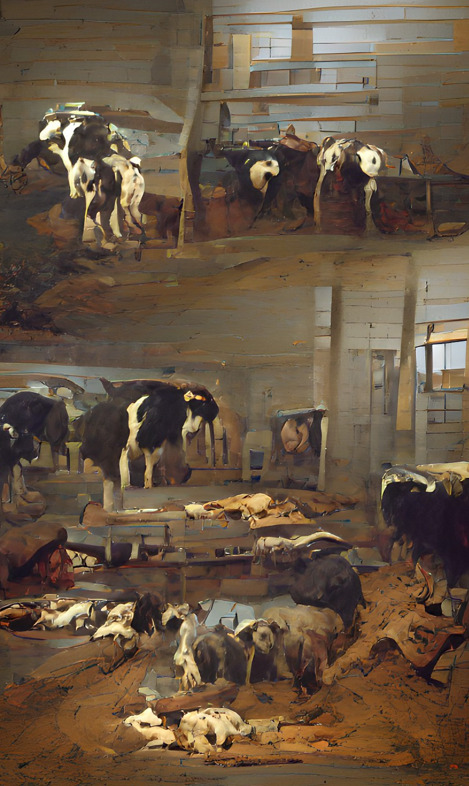


New Concepts for Music And Sound – Part 1
To make in clear right at the beginning: this series of articles is not about having fun with or through music – not at all!
And let me begin in a rather vicious – and deliberately unfair – manner.
Imagine no piece of music had a title nor did it mention the author, the composer or the producer. And in case of songs – the worst of all musical forms – the name of the singer (or the singers to make a worst thing worse) wasn´t mentioned either.
Now be honest: would you be able to tell, if you had already heard the piece, or not? If it was sung (to mention the worst case again) by a certain torturer or by another? If you had heard the sounds, the timbres more than a thousand times or less often? And what about the chord progressions (there are chord progressions in it, right? - well more chord than progression in most cases)? And the melodic phrases, aren´t they somewhat familiar to you – since the late 1990s at least?
“But wait a minute!” I can hear you shouting (well, at least thinking). “It´s not me, who you are writing about! I´m an underground consumer!” Instead of “underground” you may say “progressive ambient”. Or “experimental”. Or “serious electronic”. Or “noise”. Or “serious contemporary”. You name it.
Let me answer to your objection by asking back:
Haven´t we even had these things long enough? Setting pianos on fire, breaking glass panes on the stage, even don´t doing anything. Plings and plangs, and crash and boom, and radio noises of all kinds. Or switching on a wall of synthesizer modules and letting them do what they want for hours and hours. We even have had music made with a couple of tractors in the field. We have been listening to noise of all kinds. We have heard recordings of cows crying of fear in the slaughterhouse while a string quartet is playing lullabies life on stage. Shall I continue? Do I have to continue to make you understand what I mean?
Imagine you were listening to the radio (yes, the old fashioned one – no mobile phone, no internet radio, no listening to a piece again whenever you like). How many pieces of contemporary music are there, which you would listen to until their complete end, even for the price of missing the bus and having an ugly conversation with your boss therefore?
Are there any sonic events that are worth crawling out of bed in the morning?
Is there still anything out there in the world of music and sound that is capable of surprising you? I mean REALLY surprising, so that you are standing there, open mouthed, and thinking: “WHAT THE F**K IS THAT?”
And what about you, you virtuosos of so called classical serious music? You have toiled for endless years only to play in front of an audience, three quarters of which have only come because of the business meetings outside at the champagne bar in the break, and the majority of the remaining quarter is simply looking for a suitable spouse for their children (or offering to be one). And you yourself? Are you producing something surprising? Something else than the other 5 or 6 top instrumentalists in the world? Something really individual? Something with differences of real meaning?
Hereby I invite you. You all. You fine players of instruments, you composers and producers, you worshippers of noise or ambient, you consumers of endlessly blaring pseudo-music, of the same piece again and again, always with another title though, and another face opening and closing their mouth, you regular visitors of classical piano concerts, you aged punks, you nostalgic “our music was better back in the days” freaks.
Be invited to an ugly expedition to new sonic worlds, to new – really new – ways of thinking about sonic goings on, new ways of consuming sonic events, new ways of generating sonic goings on – to new concepts of music and sound.
... to be continued
0 notes
Text

Teaching Generative Music With Modular Synths – Part 15
Chapter 5: Generative Music And Compositional Will
Let´s not forget the basic definition of the term “generative music”: The human sets the rules and the machine starts working and proceeding according to these rules. Sounds easy. But does this mean, that my active participation (and responsibility) as the composer ends after having set up these rules?
And how far “into” the piece of music do these rules cause – and what? The last part of this question, the “what”, leads us to another question: how and to what amount can I foresee and determine the sonic character of the piece by knowing these fundamental rules?
Or in other words: What are the “rules of these rules”, their “physics”, their interrelations, which make them work and produce the piece of sonic events? I have to know this to be able to set these rules consciously – without this knowledge and understanding, without being conscious about these interrelations and working mechanisms I could hardly be called a composer – perhaps not even a producer, but would stay at the level of just a “fiddling around guy” pretending to have achieved something (but nevertheless selling quite well often enough). Well, let´s take a header into unfamiliar waters.
We are in the world of modular synthesizer systems. In other areas (worlds) of algorithmic composition, the physical manifestation of the underlying rules is program code. In our world it is modules and cables, which is a lot more obvious and demonstrative on one hand, but carries a lot less systematics and structure in itself on the other hand.
One way to find a sensible route through the jungle will therefore be to develop a collection of useful patch strategies and sub-patches, strategies that make is possible to set up a kind of “compositional master plan” for a larger, more extensive generative patch.
A last warning before I introduce the first example (and with that the first of the mentioned kinds of strategies): it will be unavoidable that this chapter 5 will overlap thematically with chapter 6. So I will have to work with cross-references here as well as in chapter 6 from time to time.
… to be continued
Stay creative and enjoy your day!
Rolf
or what about visiting our Facebook group: https://www.facebook.com/groups/rofilmmedia
#generative#generativemusic#modularsynths#musicproduction#sounddesign#sequencer#sequencers#makinggenerativemusic#modulargenerative#generativemodular#learninggenerative#learningmodular
0 notes
Text
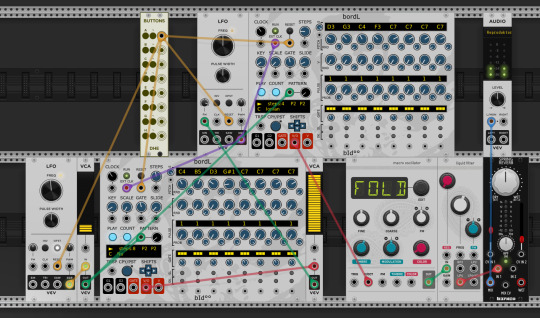
Teaching Generative Music With Modular Synths – Part 14
Chapter 4b: More Diverse Special Random Operations
The next example is with words. The words “love – and – hate – children – same – mother” are fed into a random mixer, each in its own channel (the word “mother” occupies three channels, and the word “love” is sent through a delay). The mixer randomly blends the channels in and out. Using a trigger pulse (second part of the video) the blend changes only when a trigger pulse arrives. We can achieve the same even without a special random mixer module by using random switches and VCAs. The preset is called “chapter_4_preset_1”, and the video is hiding behind the following link: https://youtu.be/xatc-VqmZlo
An alternative to a random mixer is a random gate. Here the parts are not blended into each other but activated in random order. We hear only one word at a time. The preset “chapter_4_preset_2” and the following video demonstrate this: https://youtu.be/lLmZByUENUg
I did a social-acoustic survey to get random looking results with sociological meaning. Or in other words: How does the sociological structure of my town sound like?
Well, let me explain. I took a picture (you can take any picture) and showed it to the people. I simply asked everybody - in fact I asked only 4 people (I´ve got 5 adult children, but 1 of them lives abroad - it´s about the principle, not the result). The first question was: “How do you like this picture on a scale from 1 to 10?” There was also a second question: “How often do you drink beer in a week? Every day? Every second day? ...” I took the numbers I got from the first question and transferred them to notes on a scale/octave, and the numbers from the second question (always both from the same person) to set the length of the note. I did this twice to get two different patterns.
What I got was the preset “chapter_4_preset_3” shown in the video clip behind the following link:
youtube
In the preset the patch switches between the two gained patterns. I could have made the rate of switching dependent on another survey, but I didn´t.
Alright, this was not a serious sociological-random-generative-sonic experiment, but I could have been! Choosing meaningful pictures, choosing certain groups of people (and more than only 4! And no relatives!) and comparing the sonic results may well be an interesting experience.
Some words about the patch now. The BUTTON module makes the two LFOs as well as the two sequencers start and run synchronously. And the VCA between the switching LFO down on the left side acts as an attenuator taking care, that the sequencers switch only between the first 2 patters (I produced only 2 patterns as I told you above).
The sequencer in the lower row modulates the rate of the (synchronously running) LFO in the upper row, which delivers the clock for the sequencer in the upper row (which delivers the pitch CV). And so the sequencer down there sets the length of each note by determining how long the sequencer in the upper row stays at each individual step.
With more and longer patterns, real surveys and interesting pictures to show the people we can get musically nice results, which are random in most of their aspects, but nevertheless (kind of) based on sociology.
And in case we wanted less sociology based and more changing results, we can remove the button module and stop make things run synchronously.
Alright! I think it is time for less off-the wall methods and thought now. There are a lot of basic (and perhaps more serious) strategies left to talk about before we are prepared for “extensive patching”, prepared well enough to not get lost.
… to be continued
Stay creative and enjoy your day!
Rolf
or what about visiting our Facebook group: https://www.facebook.com/groups/rofilmmedia
#generative#generativemusic#modularsynths#musicproduction#sounddesign#sequencer#sequencers#makinggenerativemusic#modulargenerative#generativemodular#learninggenerative#learningmodular#Youtube
0 notes
Text

In part 3 of my series “The Cradles of Electronic Music” I produce a 50s-style piece of electronic music using “Berna 3”. This project shows the difficulties as well as the special kind of inspiration which the pioneering musicians of the early 1950 met in their studios. The whole article is far too long to be published here. Therefore I´ve put it on my website https://dev.rofilm-media.net There´s also a video there showing me producing like Stockhausen and co.
Enjoy your day!
Rolf
#musicproduction#electronicmusicproduction#electronicmusic#earlyelectronicmusic#stockhausen#vintageelectronicmusic#berna3
0 notes
Text


The Cradles of Electronic Music – Part 2
… but it all sounds rather “far away in the past”, and quite theoretical. IT IS NOT! And I´m not going to bore you with mere theory. There is a software called “Berna” (most up to date version: “Berna 3”).
Berna is a simulation of these early electronic music studios. It contains equipment from the mentioned studio in Milan as well as from the studio in Cologne. But it is not just the old functionality packed in software, not just a bunch of physical/electronic functions transferred to code.
Berna 3 (= version 3 of Berna) is a real studio. It looks like the real thing, it works like the real thing (even the wheels of the tape machines are turning), and - perhaps most important – it even sounds like the real thing!
You have to work with Berna 3 like Maderna, Eimert, Stockhausen and Co. had to work in these studios about 70 years ago. Berna 3 revives the spirit of those pioneers, it makes the atmosphere, the way of thinking and the way of looking at music and music production come alive again.
In that aspect Berna 3 is new, is up-to-date, is revolutionary. I´m probably older than most of you, my dear readers, and so I think that not that many of you still know how it is/was to produce with reel-to-reel machines, how it is/was to record the radio noise between the stations of an old analogue wooden radio, or how beautiful and exciting a simple analogue (not digitally clean) sine wave can sound when sent through an old analogue plate reverb. Just go and answer to yourself: what would I do, if I didn´t have anything else than that sine wave, a tube amplifier, a 10-band graphical equaliser with “terribly/wonderfully non-musical” bandwidths” and a 4 track tape recorder?
And perhaps, after some time of experimenting with Berna 3, you may ask yourself a second question: “Now, that I have begun to understand how huge a jump it was from making music with guitars, violins and pianos to making music with sine wave generators and plate reverbs, what would be an equally huge jump from making music with our contemporary electronic instruments to making music …. with what? How? what for? And why?”
Sometime I read that Berna 3 is a great platform to learn about the basics of sound, and/or to learn about the basics or history of working with electronic sounds. And that is true – for sure.
But Berna 3 is far more than that. It might well be the piece of software, that will help initiate this next “huge jump”, in that it helps us to leave our musical (producer) comfort zone, and to look beyond our own noses.
Berna 3 contains 39 of the old machines (sound generators, filters, reverbs, tape recorders, loopers, an oscilloscope etc.). To connect the inputs and outputs we have to use a Matrix (there are no virtual cables, which is the only thing that´s different than in the real studios).
Well, let´s get started.... (to be continued)
More on my website: https://www.dev.rofilm-media.net/node/511
#electronicmusic#earlyelectronicmusic#vintagelectronicmusic#em#electronicmusicproduction#musicproduction#sounddesign
0 notes
Text
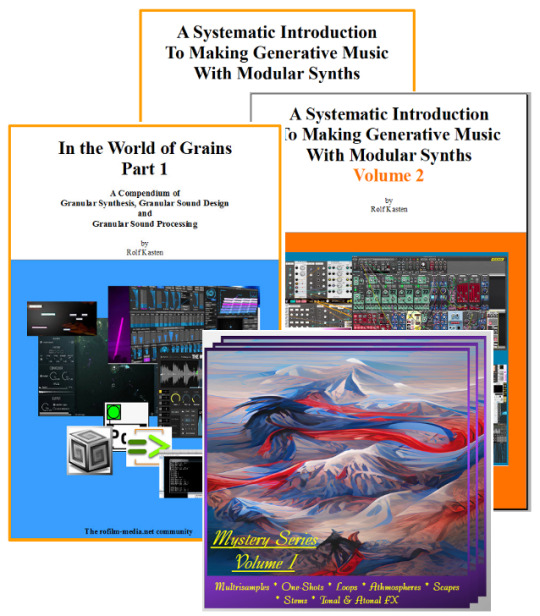
My biggest End-of-Year Sale ever!
3 E-books, all in all 768 pages including 296 videos and 208 presets
plus a 50% sales discount on my next sample pack “Mystery Series” Volume 1 (coming 20 January 2023) including multisamples, one-shots, loops, atmospheres, stems and scapes.
The 3 E-books are:
“A Systematic Introduction To Making Generative Music With Modular Synths”, Volume 1
(see the content here: https://www.dev.rofilm-media.net/node/331)
“A Systematic Introduction To Making Generative Music With Modular Synths”, Volume 2
(see the content here: https://www.dev.rofilm-media.net/node/467)
“In the World of Grains”, Volume 1
(see the content here: https://www.dev.rofilm-media.net/node/332)
The “Mystery Series” material contains carefully handcrafted sounds. Combining field recordings with classical hardware synths as well as with the most up to date software instruments, refining the results using sophisticated (partly self-written) software tools and putting it all together to a mesmerising sonic journey into a fantastic world: that´s my new series of sample packs called the “Mystery Series”. It´s conic metaphysics, it´s audible fantasy, and it´s a unique toolbox for every soundtrack composer, game sound producer, story teller ….
All of this: 3 E-Books plus a 50% sales discount on “Mystery Series” Volume 1 (coming 20 January 2023) for altogether
39,- $
Please click here to take advantage of this big End-of-Year offer:
#musicproduction#modularsynths#sounddesign#learningmodular#generative#generativemodular#generativemusic#learninggenerative#makinggenerativemusic#modulargenerative#granular
0 notes
Text

VCV Rack in a nutshell #8 is online now:
youtube
This short and to the point explanation of VCV Rack modules no. 8 deals with MindMeld´s “ShapeMaster”, a (looping) multi-stage envelope generator with a lot of additional functionality on board.
0 notes